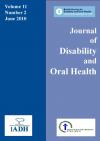Journal of Disability and Oral Health

- Cover Date:
- June 2010
- Print ISSN:
- 1470-8558
- Vol:
- 11
- Issue:
- 2
editorial.pdf
Valuing People The contents of this issue of the Journal reflects a disappointing lack of access, availability and acceptability about services for people with disabilities. Each paper documents, whether it is about the delivery of services, access to appropriate care or consideration about real involvement in research, areas where disabled people are not treated in an inclusive manner nor equitably. The Journal is now nearly ten years old and in that time, in the UK at least, there have been significant advances in making special care dentistry available to many more people; the speciality has become recognised, the availability of education and training of the dental team has become more widespread, the UK’s General Dental Council has opened up its Specialist List and 119 specialists to date have been added to that list, mostly by mediated entry and one through the academic route. A number of consultant appointments have been made around the UK and a small number of three-year training places have been funded. How has this impacted on people with disabilities? If the contents page of this issue and others is to be believed, the answer must be, some progress but a lot more to do. To an extent, lack of significant advances for vulnerable patients is due to a paucity of an evidence base around what we do; that is not to say that things do not happen for special groups but rather they do so in an uncoordinated and fragmented way and sometimes not at all; because oral health is not valued by others and there are no guidelines around what we should be doing. In part, it is a lack of suitably educated and trained dental personnel. A recent report from the Dental Schools Council in the UK highlights this ((Dental Schools Council, 2010). In the autumn of 2009, there were only 4.7 FTE (full-time equivalents) in Special Care Dentistry, across all grades, recorded as clinical academics in British universities. This compares with 41.4, 22.5 and 25.6 FTEs in three specialities traditionally close to Special Care: Paediatric Dentistry, Public Dental Health and Oral Medicine, respectively. By contrast, there are 7.7 and 169.3 FTEs in Oral Radiology and Restorative Dentistry, respectively. Of note, Special Care Dentistry is the only speciality in dental schools in the UK where the gender balance is in favour of females at 66.7%. The report makes the point that ’the dental health of the population and the teaching of future generations of dentists depends on improved levels of recruitment into and retention of dental clinical academics’. Without an academic base to support the development of education and training in Special Care Dentistry,
not only of clinical academics but also the entire dental team, including their on-going continuing dental education needs, the speciality and what it hopes to achieve, will struggle. Having achieved so much in securing both specialist and consultant posts to deliver service and some education and training, this deficiency must be addressed. June Nunn, Editor, Dublin May 2010.
References
Dental Schools Council. Clinical Academic Staffing levels in the UK Dental Schools. 2010.
- Article Price
- £15.00
- Institution Article Price
- £
- Page Start
- 50
- Page End
- 50
- Authors
- June Nunn
Articles from this issue
- Title
- Pg. Start
- Pg. End
- Dental health research (1997-2007) concerning people with learning disabilities: a systematic review addressing the extent to which they are involved in research
- 91
- 96
